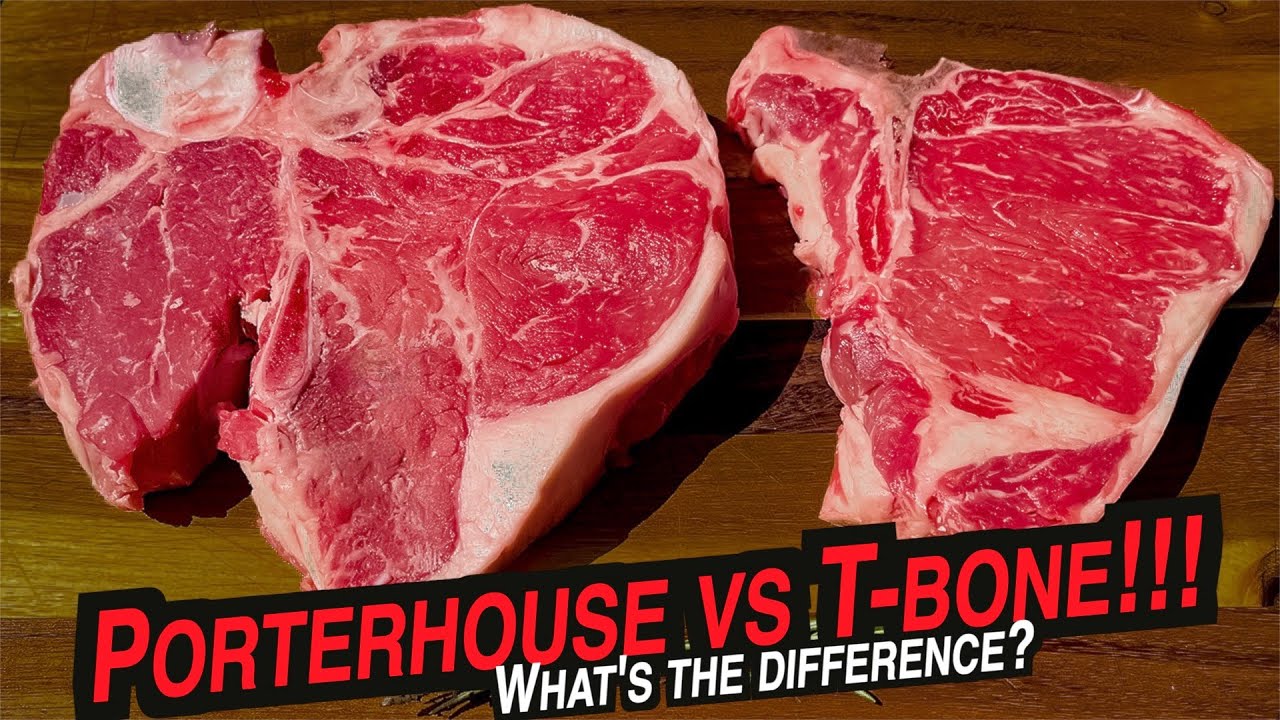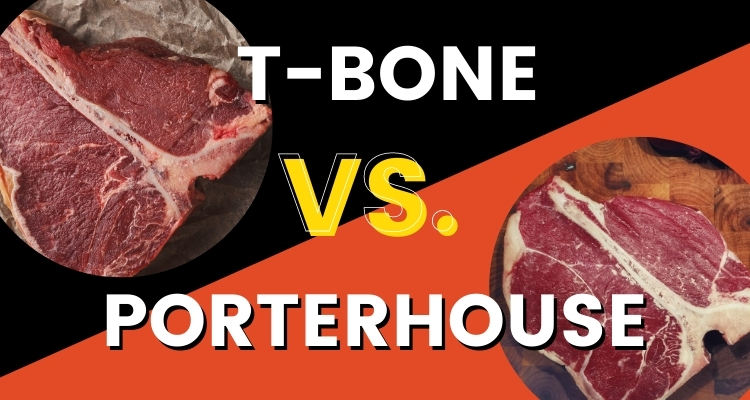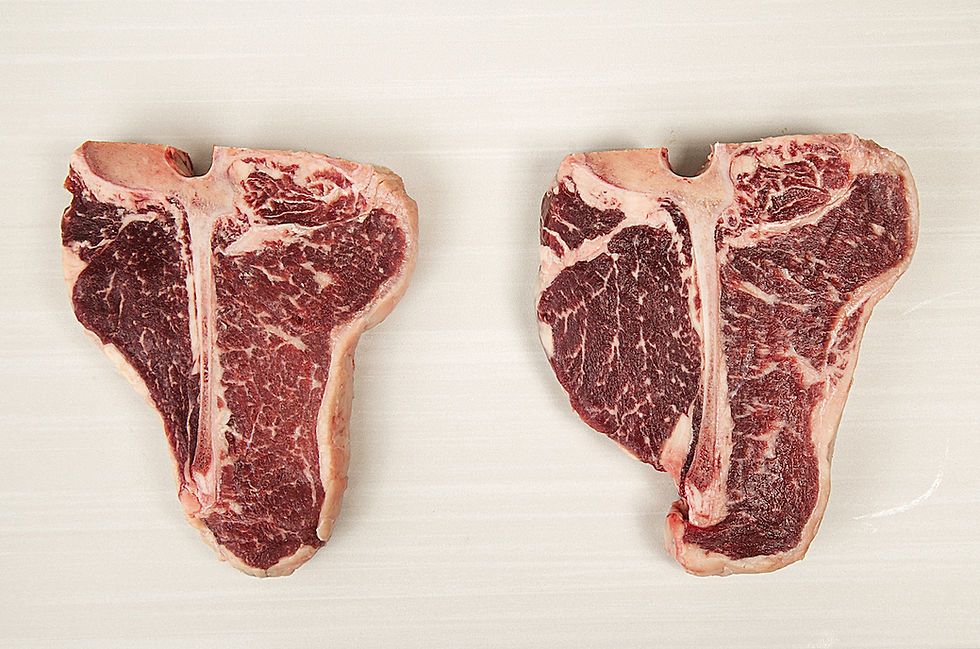Understanding Steak Cuts

Steak cuts can be confusing, but it’s important to understand the differences in order to choose the perfect cut for your preferences. The T-bone and Porterhouse steaks, for example, are both cuts from the short loin area of the cattle. The key distinction between the two lies in the size of the filet mignon portion. T-Bones have a tenderloin length less than 1.24 inches, while Porterhouses have a tenderloin length of 1.25 inches or greater. Both cuts offer a combination of a flavorful strip steak and a tender filet mignon.
Differentiating Between T-bone And Porterhouse Steaks
When it comes to differentiating between T-Bone and Porterhouse steaks, the key distinction lies in the size of the filet mignon portion. T-Bones have a tenderloin length of less than 1.24 inches, while Porterhouses have a tenderloin length of 1.25 inches or greater. This slight difference in size can affect the overall flavor and tenderness of the steak. Both cuts offer a combination of a flavorful strip steak and a tender filet mignon, making them popular choices for steak lovers. So, whether you prefer a smaller or larger filet mignon portion, knowing the difference will help you choose the perfect steak for your preferences.
An Overview Of T-bone And Porterhouse Cuts
The T-Bone and Porterhouse cuts are both derived from the short loin area of cattle and are highly desired by steak lovers. These cuts get their names from the distinctive T-shaped bone that runs through them. The T-Bone steak consists of a flavorful strip steak on one side of the bone and a tender filet mignon on the other. On the other hand, the Porterhouse steak boasts a larger filet mignon portion, making it a perfect choice for those who prefer a bigger tenderloin. Both cuts offer a perfect combination of tenderness and flavor, making them a favorite among steak enthusiasts.
T-bone Steak Analysis

The T-Bone steak is a classic cut that offers the perfect combination of tenderness and flavor. It is known for its well-marbled strip steak on one side of the bone and a juicy, tender filet mignon on the other. The strip steak provides a rich, beefy flavor, while the filet mignon offers a melt-in-your-mouth tenderness. When grilled to perfection, the T-Bone steak develops a delicious crust on the outside while maintaining a juicy and tender interior. It is a favorite among steak lovers for its versatility and incredible taste.
T-bone Steak Characteristics And Flavor
T-Bone steaks are renowned for their unique characteristics and distinctive flavor profile. The most notable feature of the T-Bone steak is its bone, which divides the steak into two sections: a strip steak on one side and a tender filet mignon on the other. This combination creates a perfect balance between tenderness and rich beefy flavor. The strip steak is marbled with fat, adding juiciness and enhancing the overall taste. The filet mignon, known for its unmatched tenderness, melts in your mouth with each bite. When cooked to perfection, the T-Bone steak develops a flavorful crust on the outside while maintaining a juicy and tender interior. Its robust, beefy taste and succulent texture make it a favorite choice for steak enthusiasts.
T-bone Steak Cooking Tips And Recommendations
When it comes to cooking T-Bone steaks, there are a few key tips and recommendations to ensure the best results. First, it’s crucial to bring the steak to room temperature before cooking to promote even cooking. Secondly, sprinkle the steak with salt and let it sit for about 30 minutes to enhance the flavor and tenderness. For grilling, preheat the grill to high heat and sear the steak for about 2-3 minutes on each side. Then, reduce the heat and continue cooking until desired doneness. Lastly, let the steak rest for about 5-10 minutes before slicing to allow the juices to redistribute and ensure a moist and tender steak. By following these tips, you’ll be able to enjoy a perfectly cooked T-Bone steak every time.
Porterhouse Steak Analysis

Porterhouse steaks are known for their impressive size and delicious flavor. Cut from the rear end of the short loin, the porterhouse contains a larger portion of tenderloin compared to T-bone steaks. This generous amount of tenderloin gives the porterhouse a buttery texture and adds an extra level of tenderness to each bite. Additionally, the strip loin side of the porterhouse is well-marbled, resulting in a steak that is bursting with flavor. It’s important to trim any excess fat from the steak before cooking, whether you choose to grill or cook it in an iron skillet. Overall, the porterhouse steak offers a truly indulgent dining experience for steak lovers.
Porterhouse Steak Attributes And Texture
The porterhouse steak is widely celebrated for its impressive attributes and luxurious texture. Not only does it offer a generous portion of tenderloin, known for its melt-in-your-mouth tenderness, but it also boasts a well-marbled strip loin side that adds a burst of flavor to each bite. The combination of these two cuts creates a steak that is succulent, buttery, and rich in flavor. The porterhouse’s thickness ensures a juicy and tender texture, allowing for a truly indulgent dining experience. With its ample marbling and tender meat, the porterhouse steak is a true delight for steak enthusiasts.
Porterhouse Steak Cooking Methods And Seasoning
When it comes to cooking a porterhouse steak, there are several methods that can bring out the best flavors and textures. One popular method is grilling, which allows the steak to develop a delicious charred crust while retaining its juicy interior. For those who prefer indoor cooking, searing the steak in a hot skillet can also yield excellent results. Seasoning is key to enhancing the natural flavors of the porterhouse. A simple combination of salt, pepper, and garlic powder can do wonders, or you can experiment with marinades and rubs to add additional layers of flavor. Whichever method and seasoning you choose, be sure to allow the steak to rest before slicing and serving to ensure maximum tenderness.
Nutritional Comparison

When comparing the nutritional values of T-Bone and Porterhouse steaks, it becomes evident that there are slight differences between the two cuts. The T-Bone steak is leaner and has a slightly lower cholesterol content compared to the Porterhouse steak. However, the T-Bone steak also contains more meat, resulting in a higher iron content. It’s worth noting that both steaks are high in protein and provide essential nutrients, including Vitamin B-12. Individuals with specific dietary concerns, such as cholesterol levels, may prefer the T-Bone steak for its slightly lower cholesterol content. However, both steaks can be enjoyed as part of a balanced diet.
Nutritional Value Of T-bone And Porterhouse Steaks
T-Bone and Porterhouse steaks are both packed with essential nutrients. They are excellent sources of protein, providing the necessary building blocks for muscle growth and repair. Additionally, both steaks contain high levels of Vitamin B-12, which is crucial for a healthy nervous system and red blood cell production. However, when comparing the two cuts, the T-Bone steak is leaner and has slightly lower cholesterol content than the Porterhouse steak. It’s important to note that both steaks can be enjoyed as part of a balanced diet, providing a delicious and nutritious meal.
Health Considerations When Consuming T-bone Vs Porterhouse
When it comes to health considerations, there are a few factors to keep in mind when consuming T-Bone and Porterhouse steaks. Both cuts are high in protein, which is important for muscle growth and repair. However, due to their marbling and fat content, these steaks can be higher in saturated fat and cholesterol. It’s important to enjoy these cuts in moderation and as part of a balanced diet. Additionally, for individuals watching their sodium intake, it’s worth noting that these steaks may contain some sodium, depending on how they are seasoned or marinated. It’s always a good idea to consult with a healthcare professional or nutritionist to ensure that these steaks fit into your dietary needs and goals.
Cooking Techniques

When it comes to cooking T-Bone and Porterhouse steaks, there are a few techniques that can help you achieve optimal results. For grilling, it is recommended to sear the steaks over high heat to form a crust, then move them to indirect heat to cook them to the desired doneness. This ensures that the steaks are cooked evenly and retain their juices. Additionally, using a meat thermometer can help you determine the internal temperature and ensure the steaks are cooked to your preference. After cooking, it is important to let the steaks rest for a few minutes to allow the juices to redistribute throughout the meat. By following these techniques, you can enjoy a perfectly cooked T-Bone or Porterhouse steak every time.
Best Practices For Grilling T-bone And Porterhouse Steaks
For grilling T-Bone and Porterhouse steaks, it is important to follow some best practices to ensure a delicious and tender result. Firstly, preheat the grill to high heat to achieve a good sear and develop a caramelized crust on the steaks. Place the steaks directly over the heat source and sear them for a few minutes on each side. Then, move the steaks to indirect heat to continue cooking until they reach the desired level of doneness. This method helps to cook the steaks evenly and retain their natural juices. Remember to use a meat thermometer to accurately gauge the internal temperature. Finally, let the steaks rest for a few minutes to allow the juices to redistribute before serving. Following these grilling techniques will ensure perfectly cooked T-Bone and Porterhouse steaks that are tender and full of flavor.
Cooking Temperatures And Resting Times For Optimal Results
When it comes to cooking T-Bone and Porterhouse steaks for optimal results, it is essential to pay attention to cooking temperatures and resting times. For a perfectly cooked steak, the ideal internal temperature is 130-135°F (54-57°C) for medium-rare, and 140-145°F (60-63°C) for medium. Use a meat thermometer to accurately gauge the steak’s doneness. Once the desired temperature is reached, it is crucial to let the steak rest for about 5-10 minutes. This resting period allows the juices to redistribute, ensuring a juicy and tender bite. It’s tempting to dive right into the steak after grilling, but patience during resting is rewarded with incredible flavor and texture.
Conclusion

In conclusion, understanding the differences between T-Bone and Porterhouse steaks can elevate your steak experience. While both cuts offer a combination of filet mignon and strip steak, the key distinction lies in the size of the filet mignon portion. The Porterhouse boasts a larger tenderloin, resulting in a more tender and delicate flavor, while the T-Bone delivers a robust beef taste. Whether you prefer tenderness or boldness, both cuts guarantee a satisfying steak experience. So, the next time you fire up the grill, choose the cut that best suits your preferences and enjoy a delicious steak feast.
Summarizing The Differences Between T-bone And Porterhouse Steaks
T-Bone and Porterhouse steaks may appear similar, but there are key differences that set them apart. The primary distinction lies in the size of the tenderloin portion. T-Bone steaks have a smaller filet mignon section, while Porterhouse steaks boast a larger tenderloin. As a result, Porterhouse steaks offer a more tender and delicate flavor, while T-Bone steaks deliver a bolder beef taste. Additionally, due to the larger filet mignon portion, Porterhouse steaks tend to be more expensive. Ultimately, the choice between the two cuts depends on personal preference and the number of people being served.
Final Thoughts And Recommendations
In conclusion, when it comes to choosing between T-Bone and Porterhouse steaks, it ultimately boils down to personal preference and the amount of tenderloin desired. The T-Bone steak offers a bolder beef flavor, while the Porterhouse steak provides a more tender and delicate experience. Both cuts are delicious and highly sought after, so it’s worth trying both to see which one suits your taste buds. Remember to follow proper cooking techniques and temperatures to ensure optimal results. Whichever you choose, be prepared for an indulgent and satisfying steak experience.
FAQ About T Bone Vs Porterhouse: Deciphering Steak Cuts
Q: What is the main difference between a T Bone and a Porterhouse steak?
A: The main difference lies in the size of the tenderloin portion. A T Bone steak has a smaller section of tenderloin compared to a Porterhouse steak, which has a larger tenderloin piece.
Q: How can one distinguish between a T Bone and a Porterhouse steak visually?
A: To identify them visually, look at the size of the tenderloin muscle. In a Porterhouse steak, the tenderloin portion will be significantly larger compared to that of a T Bone steak.
Q: Which part of the T Bone and Porterhouse steak is generally more tender?
A: The tenderloin portion, also known as the filet mignon, is the most tender part of both T Bone and Porterhouse steaks due to its location in the anatomy of the cow.
Q: Are there any specific cooking methods recommended for T Bone and Porterhouse steaks?
A: Both cuts benefit from high-heat cooking methods like grilling, broiling, or pan-searing. It’s essential to cook them to the desired level of doneness to ensure the best eating experience.
Q: Can the T Bone and Porterhouse steaks be used interchangeably in recipes?
A: Yes, due to their similar cuts and flavors, T Bone and Porterhouse steaks can often be used interchangeably in recipes calling for a thick, bone-in steak.
Q: Are there any specific serving suggestions for T Bone and Porterhouse steaks?
A: To enjoy the full flavor of these steaks, it’s recommended to serve them hot off the grill or skillet with simple seasonings like salt, pepper, and a pat of butter. Accompany them with your favorite sides and a glass of red wine for a classic steakhouse experience.

Johnny Knuckles Knock-out BBQ is a culinary haven for barbecue enthusiasts, offering a fusion of traditional BBQ and tantalizing street fare. Our secret to delivering mouthwatering dishes lies in our meticulous preparation process. Each cut of meat is lovingly hand-rubbed and slow-smoked over 100% hardwood, creating a symphony of flavors that will leave your taste buds dancing. Whether planning a special event or simply craving an unforgettable meal, Johnny Knuckles Knock-out BBQ is here to elevate your dining experience. Our catering services are designed to bring the sizzle and aroma of our delectable BBQ to your event, ensuring that every guest leaves with a full belly and a smile.